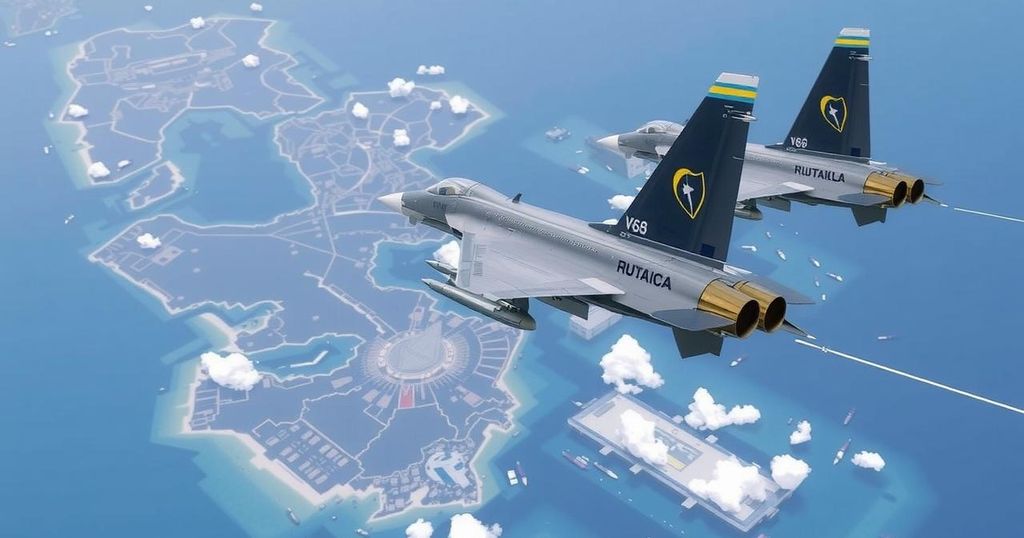Following the ousting of Bashar al-Assad, Russia has intensified its military flights from Syria to Libya, particularly to the al-Khadim airbase near Benghazi. This shift aims to secure an operational hub for military activities in North Africa, while maintaining a presence in the Mediterranean. The increased flights highlight Russia’s efforts to adapt to changing regional dynamics and the resulting implications for NATO and local alliances.
In recent weeks, following the ousting of Bashar al-Assad as Syria’s leader, Russia has significantly increased its military flights to a desert airbase in Libya. This strategy appears to be aimed at establishing an alternative logistical hub for its military operations in Africa, thus ensuring a sustained presence in the Mediterranean. Traditionally, the Hmeimim air base in Syria served as a critical point for Russian military activities, but the current geopolitical climate has necessitated this shift. Flight data indicates a daily influx of aircraft, primarily Antonov AN-124 and Ilyushin IL-76, from Hmeimim to the al-Khadim base near Benghazi, underlining the urgency of this strategic maneuver.
U.S. and Western officials have recently noted that Russia has started withdrawing troops and military equipment from Syria, which may include advanced air defense systems. The shifting dynamics are evident as geolocated videos confirm that some aircraft have continued their journey from Libya to Mali, indicating a broader logistical transition.
Experts highlight that the Russian air force has increased its activity in Libya, with Jalel Harchaoui noting a marked increase in landings of Russian aircraft in recent weeks. This escalation in activity suggests that Libya is becoming a vital linchpin in Russia’s efforts to maintain influence in the Mediterranean. The establishment of a secure transit point for personnel and military supplies at al-Khadim is seen as a critical component of these efforts.
Russia’s connections with Libyan warlord Khalifa Haftar, who commands significant territory but remains a divisive figure in Libya, further complicate the situation. Concerns among NATO members persist, especially with Italian officials warning of the implications of Russian naval capabilities becoming more proximate to their shores. The prospect of Russian naval presence in the Mediterranean raises alarms akin to those during historical tensions in the region.
It remains unclear whether Syria’s new leadership will oust Russian military from established bases, even as signals suggest that some level of cooperation might continue under specific terms. Strategic analysts express skepticism about the long-term viability of Russian positions in both Libya and Syria, especially given the unpredictability surrounding Haftar’s allegiance and the inherent risks tied to shifting regional dynamics. Moscow’s ability to foster reliability among African nations that previously aligned with its interests may also be diminishing in light of recent events in Syria. Overall, while Russia has adapted to the evolving landscape, the transformation has rendered their previously advantageous positions into more precarious scenarios, indicating a complex future for their military engagements.
In the context of geopolitical shifts in the Middle East and North Africa, Russia has re-evaluated its military strategies following Assad’s removal. The region has become increasingly volatile, and the traditional bases in Syria are now subject to change as internal dynamics unfold. Libya emerges as an alternative base of operations, allowing Russia to extend its influence further into Africa while maintaining its Mediterranean foothold. The change in leadership in Syria also affects Russia’s military plans, necessitating adjustments to its existing operations and relationships in the region. Moreover, the potential for Russian naval presence and expanded military cooperation with Haftar exacerbates NATO’s concerns regarding security and stability in the Mediterranean. Russia’s military operations have evolved significantly in light of these developments, with Al-Khadim presenting new opportunities to bolster its influence in North Africa. The complexities of the situation underscore the strategic importance of maintaining relationships with local powers while simultaneously adapting to changing global environments.
In conclusion, Russia’s renewed military flights from Syria to Libya signal a significant strategic shift in its operations in the Mediterranean and Africa. While Moscow seeks to bolster its presence in the region amidst the instability following Assad’s ousting, it faces challenges from both regional politics and international scrutiny. The increased activity at the al-Khadim airbase and the ongoing relationship with Khalifa Haftar highlight Russia’s commitment to retaining a foothold in North Africa. Nevertheless, the evolving dynamics and potential uncertainty surrounding local leadership may complicate Russia’s long-term objectives in the area, necessitating careful navigation of its alliances and operational strategies.
Original Source: www.cnn.com






